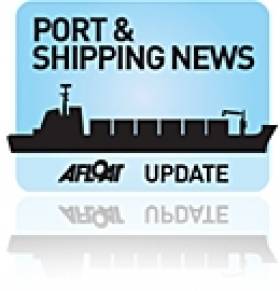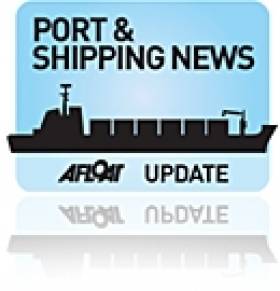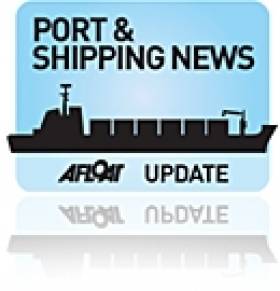Displaying items by tag: Newbuilds
The Future’s Green, Bright and Orange
This month ASN are due delivery of the 4,700 gross tonnes Arklow Bridge, the second 'B' class newbuild was also built by the Dutch company of Bodewes Shipyards B.V. She is the fifth vessel to carry this name since Arklow Shipping was founded in 1966.
The Arklow Bridge is registered in St. John's the capital of the Caribbean island of Antigua where she will be flagged. Antigua became an associated state of the Commonwealth until it was disassociated from Britain 30 years ago.
Her sister Arklow Brook entered service this year and is designed with two holds with a total (grain and bale) capacity of 9473.1m3 or an equivalent of 33,4524 ft3.
For cargo-separation the holds can be sub-divided by a portable bulkhead in up to 8 positions. In addition to carrying agricultural-based cargoes, the 116m (OA) overall long vessel can handle 177 (TEU) containers in the hold and another 88 can be stowed on top of the hold's hatch covers. Both the holds are fitted with dehumidifier's.
The power-plant is derived from a MaK 6M32C 2999kW main engine with a Renk gearbox and Berg controllable pitch propeller that provides around 12 knots.
With the entry of Arklow Bridge, the combined fleet is over 40 ships that trade in the north-west of Europe and the Mediterranean. For further vessel statistics of the sisters click here and for a photo of the new vessel click this link.
Asides the Rotterdam based operation of ASN, the Irish side of the company is the largest indigenous owned shipping company in terms of Irish-flagged and registered tonnage. Arklow is not only the headquarter's of ASL but the homeport is also where the vessels are registered.
- Dublin Port
- Co. Wicklow
- Arklow Shipping
- Newbuilds
- The Netherlands
- Arklow Shipping Ltd
- Ports and Shipping News
- Caribbean
- DryDock
- Antigua
- British
- Dublin Port news
- Arklow Bridge
- Arklow Brook
- ASN
- Arklow Shipping B.V.
- Irishflagged
- Irishregistered
- Arklow Future
- Bodewes Shipyards
- Dutchflagged
- Antiguaflagged
- Mak
- The Commonwealth
- River Avoca
Speaking at the ceremony Mr. Murphy commented: "d'Amico Group are one of a leading number of firms that are driving investment in this sector in Ireland which is contributing to new employment and growth opportunities".
Entry of the new dry-bulkers marks another important chapter in the d'Amico Group's development since it established its Irish office in 2002, as the vessels are managed from its Dublin office under the Irish Tonnage Tax (ITT) regime.
Four more newbuilds are under construction in Korea, scheduled for delivery in 2012, and two under construction in Japan which are due in 2013. The latter ships represent a further investment in excess of US $310 million to the Italian company that began and grew as a family business in 1936.
To read more about this logon to the IMDO website and also www.damicoship.com
Expanding Fleet at Ardmore Shipping
The newbuilds contracts are for a pair of 17,000 deadweight tonnes (dwt) chemical tankers which will be IMO II classified. The 144m twins have a beam of over 22m and a draft of 9m and they will be around 9,000 gross tonnes.
Both the newbuilds were ordered from the Hamburg-based Hellespont in 2009 and are the last in a series of eight tankers being built by the Sekwang Shipbuilding facility in South Korea. The newbuilds are expected to be delivered in April and July 2012.
In the second separate deal Ardmore Shipping has agreed to charter the Hellespont Commander and Hellespont Crusader (photo) which are also 17,000 dwt IMO II chemical tankers for a one year period with an option to extend the charter for a further year. The 2010 built vessels will enter the Navig8 Brizo-8 chemical tanker pool for trade and commodity chemicals.
Anthony Gurnee, CEO of Ardmore Shipping Ltd, commented: "We are very pleased to have taken on the contracts with Sekwang Shipbuilding for these two newbuild vessels, which will join our fleet next year, and with our charter agreement for the Hellespont Commander and the Hellespont Crusader."
The chartered vessels join the Ardmore Shipping which brings the fleet to six ships which include: Ardmore Centurion, Ardmore Seatrader, Ardmore Seamaster and Ardmore Seafarer.
When the two newbuild vessels enter service in 2012, Ardmore Shipping will still be in expansive mode as they have ordered two 51,000 dwt double hull IMO III chemical/product tankers for delivery in 2012 and 2013.
Tanker Newbuilds for Cork-Based Global Operator
Ardmore Shipping Ltd manages the activities of the Ardmore Shipping Group, which is engaged in the ownership and operation of chemical and products tankers trading on a worldwide basis. The Irish registered company runs its global fiscal operations from the group's head-office based in Cork.
Like the existing fleet, the newbuilds are also to be registered in Majuro, the capital of the Marshall Islands, a republic nation in the Pacific Ocean. The Micronesian nation of atolls and islands attained independence 25 years ago under a Compact of Free Association with the United States.
Last month, two vessels entered service for the company, the Ardmore Centurion (2005 / 28,987 dwt) formerly the Elisa, is to date the company's only joint chemical and products tanker. The second December debutant was the slightly older, Ardmore Seatrader (2002 / 47,141 dwt) a products tanker, formerly the St. Georg. In fact both vessels were handed over within a 12-hour timeframe and on opposite sides of the world.
When the second newbuild is completed in 2013, this will bring to three the number of chemical and product tankers in service, with the Ardmore Centurion, which was also built in South Korea but at the STX Shipyard Jinhae. The Ardmore Seatrader, built by the Onomichi shipyard in Japan, now forms the third product-only tanker, out of the four-strong mixed vessel type fleet.
This leaves the two remaining product tankers, the Ardmore Seamaster (2004 / 45,840 dwt) which entered service in October. The vessel was the former Formosa 12 and was also built in Japan but at the Shin Kurushima shipyard. She will be employed under a long-term charter to D/S Norden of Copenhagen.
The last vessel of the Ardmore Shipping Group fleet, is the Ardmore Seafarer (2004 / 45,744 dwt) which entered service in July. The former Zoa Express, was completed at the Minami-Nippon Usuki shipyard in Japan. She was re-named in honour of the Ardmore's seafarers and in recognition of 2010 as the International Maritime Organisation (IMO) Year of the Seafarer.
Interestingly that in the Year of the Seafarer, in particular for the welfare of the crew of the Ardmore Seafarer, she came under the threat of pirates!... While on route from Dar Es Salaam to Fujairah the vessel was attacked by the pirates, 1,000 (nm) nautical miles off Somalia and some 500 nm off the coast of India. Thanks to quick and decisive actions, Captain Benamu and his crew evaded capture, ensuring that the pirates were unable to seize control of the 179m (length) X 32m (breadth) vessel. To see a photograph of this vessel click the link HERE
South Korean Newbuilds for Arklow Shipping
The latest newbuild for the Arklow Shipping Ltd (ASL) fleet, Arklow Meadow is due to depart from the Mokpo Shipyard Corporation, South Korea in three weeks, writes Jehan Ashmore. The 136m dry-cargo vessel will seek a cargo for the delivery voyage from the Far-Eastern shipyard to Europe.
Arklow Meadow represents the fourth in a series of six newbuilds ordered, with lead-ship Arklow Manor entering service in 2009. The following newbuilds, Arklow Marsh and Arklow Mill where delivered from the shipyard to her owners during 2010.
All the 'M'-class newbuilds are 14,000 tonnes and have four-holds with a total grain capacity of over 18,000 cubic square-metres.The vessels are powered by a MaK 6M 43C main engine which has a 5,400KW capacity through a Jake reduction gear-box and fitted to a Rolls Royce controllable pitch propeller.
ASL operate a modern fleet of dry-cargo short-sea traders and bulkers throughout Europe, Scandinavia and to the Mediterranean Sea using tonnage varying in size from 3,000-14,000 tonnes. Most to the vessels are of a singledeck, box hold design and some are fitted for container stowage. The majority of cargoes are grain, general dry-bulk and bulk commodities including those classified under IMO regulations.
ASL was established in 1966 by several family ship-owning companies and has progressed to become one of Ireland's leading indigenous ship-operators. The company has its headquarters alongside the banks of the River Avoca, Arklow in addition a management team also based in the Netherlands. Most of the 39 strong fleet are registered in the Co. Wicklow port, flying the Irish tricolour while the rest of the fleet are under the Dutch flag and registered at Rotterdam and Zaandam.

































































